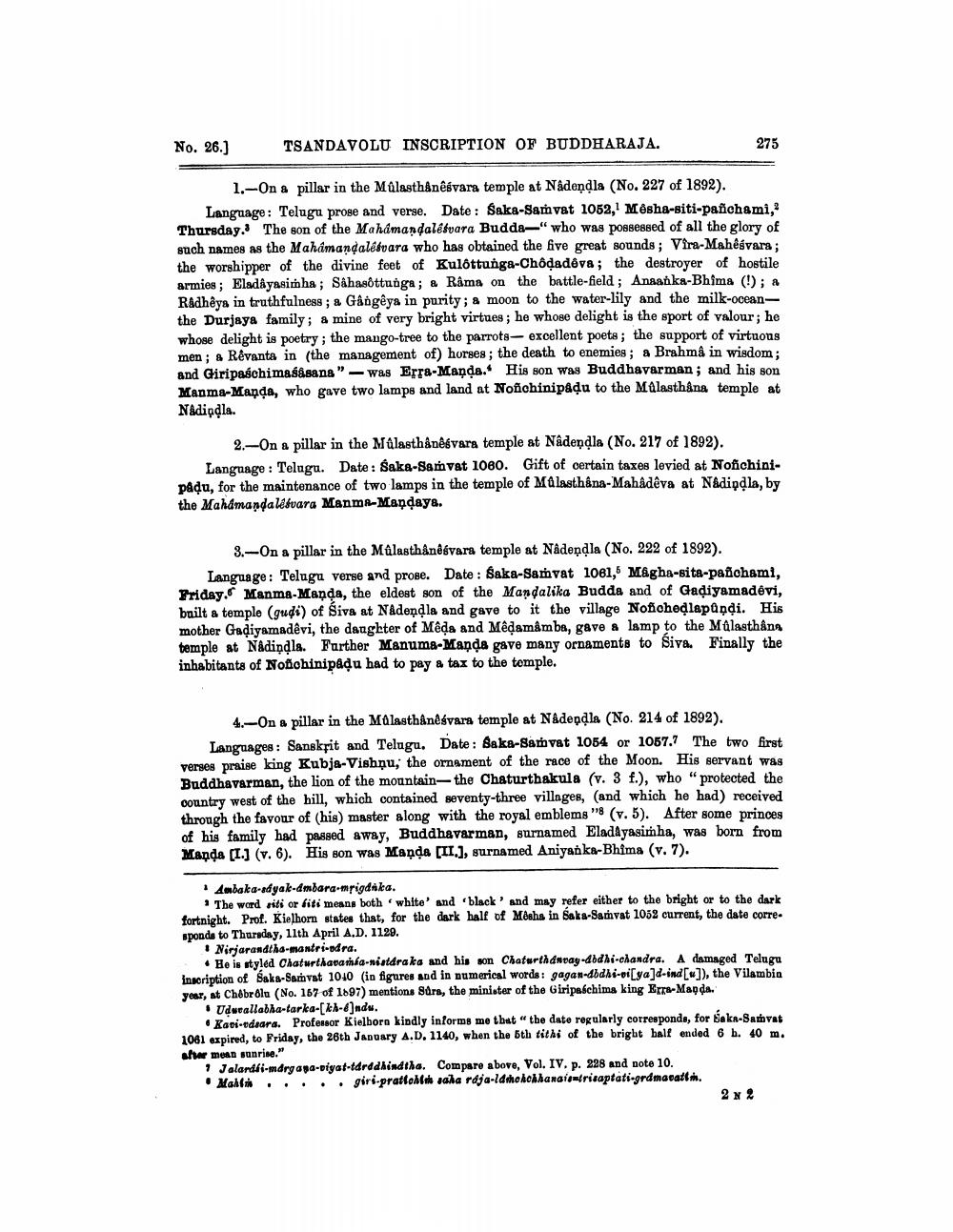________________
No. 26.)
TSANDAVOLU INSCRIPTION OF BUDDHARAJA.
275
1.-On a pillar in the Mülasthånêsvara temple at Nadeņdla (No. 227 of 1892). Language: Teluga proge and verse. Date: Saka-Samvat 1052,1 Mêsha-siti-pañchami, Thursday. The son of the Mahamandalesvara Budda—"who was possessed of all the glory of such names as the Mahamandalesvara who has obtained the five great sounds ; Vira-Mahesvara; the worshipper of the divine feet of Kulottunga-Chôdadêva; the destroyer of hostile armies; Eladâyasimha; Sahasottunga; a Râma on the battle-field; Anaanka-Bhima (!); a Radhêya in truthfulness; a Gângêya in purity; & moon to the water-lily and the milk-oceanthe Durjaya family; a mine of very bright virtues; he whose delight is the sport of valour; he whose delight is poetry; the mango-tree to the parrots- excellent poeta; the support of virtuous men ; & Rêvanta in the management of) horses; the death to enemies; a Brahma in wisdom; and Giripasohimaśåsana" -was Erra-Manda. His son was Buddhavarman; and his son Manma-Manda, who gave two lamps and land at Nofichinip&du to the Malasthåna temple at N&diqdla.
2.-On a pillar in the Múlasthåndsvara temple at Nådendla (No. 217 of 1892). Language: Telugu. Date: Saka-samvat 1060. Gift of certain taxes levied at Noñchinipadu, for the maintenance of two lamps in the temple of Mülasthậna-Mahâdêva at Nadi dla, by the Mahamandalesvara Manma-Mandaya.
3.-—-On a pillar in the Malasthånêsvara temple at Nadeņdla (No. 222 of 1892). Language: Telugu verse and probe. Date : Saka-Samvat 1061, Magha-sita-pañohami, Friday, Manma-Manda, the eldest son of the Mandalika Budda and of Gadiyamadevi, built a temple (gudi) of Siva at Nådendla and gave to it the village Noñchedlapaņdi. His mother Gadiyamadêvi, the daughter of Mêda and Mêdamámba, gave a lamp to the Mûlasthans temple at Nadiņdla. Further Manuma-Mande gave many ornaments to Siva. Finally the inhabitants of Nonohinipadu had to pay a tax to the temple.
4.-On a pillar in the Malasthåndsvara temple at Nådendla (No. 214 of 1892). Languages : Sanskrit and Telugu, Date: Baka-Samvat 1054 or 1057.7 The two first verses praise king Kubja-Vishnu, the ornament of the race of the Moon. His servant was Buddhavarman, the lion of the mountain-the Chaturthakula (v. 3 f.), who "protected the country west of the hill, which contained seventy-three villages, and which he had) received through the favour of his master along with the royal emblems" (v. 5). After some princes of his family had passed away, Buddhavarman, surnamed Elad@yasimha, was born from Manda [I.] (v. 6). His son was Manda (II.], surnamed Aniyanka-Bhima (v.7).
Aubaka-adyak-dmbara.rigdaka.
1 The word riti or fiti means both white and black and may refer either to the bright or to the dark fortnight. Prof. Kielhorn states that, for the dark half of Mahs in Saka-Samvat 1052 current, the date corre. sponds to Thursday, 11th April A.D. 1129.
Nirjarandths-mantri-ndra.
• He is styled Chaturthavathia-wiatdraka and his son Chaturthd-vay-dodhi-chandra. A damaged Telugu inscription of Saka-Samvat 1040 (in figures and in numerical words: gagan-dodhi-ni ya]d-ind[]), the Vilambin year, st Chébrölu (No. 167 of 1197) mentions Sdrs, the minister of the Giripaschima king Erra-Mapda.
• Udurallabha-tarka-[kh-d]nds.
• Kadi-tdagra. Professor Kielborn kindly informs me that "the date regularly corresponds, for Bakr-SAVAS 1061 expired, to Friday, the 26th January A.D. 1140, when the 6th tithi of the bright half ended 6 h. 40 m. ser mean sonrine."
1 Jalandhi-mdrgaya-biyat-tarddhindtha. Compare above, Vol. IV. p. 228 and note 10. • Makin ... .. giri-pratfot saa raja-ldthehehhandioritaptati.grdmaratit.
2 x 2




